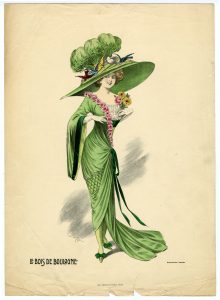 While reorganizing a selection of miscellaneous engravings recently, we came across a set of plates depicting wonderfully whimsical fancy dress ensembles. The adoption of masks or other elements of disguise for festivals and celebrations is believed to date back to 1710 in London, when theaters and public gardens threw lavish fetes where anonymity reigned, open to all—regardless of class. Identities obscured, the revelers felt free to dance, flirt and engage in activities that perhaps were not considered befitting their true station. For this reason, these parties drew the ire of moralists, and while the past time of unnamed intrigues fell largely out of fashion by the turn of the 19th century, the public did not lose their enthusiasm for a good round of playing dress up.
While reorganizing a selection of miscellaneous engravings recently, we came across a set of plates depicting wonderfully whimsical fancy dress ensembles. The adoption of masks or other elements of disguise for festivals and celebrations is believed to date back to 1710 in London, when theaters and public gardens threw lavish fetes where anonymity reigned, open to all—regardless of class. Identities obscured, the revelers felt free to dance, flirt and engage in activities that perhaps were not considered befitting their true station. For this reason, these parties drew the ire of moralists, and while the past time of unnamed intrigues fell largely out of fashion by the turn of the 19th century, the public did not lose their enthusiasm for a good round of playing dress up.
The term ‘fancy dress’ is sometimes used interchangeably with the term ‘masquerade’, but the latter has implications of anonymity that former does not. In the United States, we commonly call fancy dress a ‘costume’, but the true definition of the word ‘costume’ simply refers to a set of clothing and may include regional or seasonal forms of dress.
 This particular set of plates—which date to around 1910—depicts fancy dress ensembles based on Parisian landmarks, such as The Bastille, or the Bois de Boulogne and are not thought to be part of a larger publication, but rather a unique issue that was meant to be consumed as amusement instead of literal suggestions for the realization of fancy dress togs. The silhouette of the ensembles closely follows the fashions of the era, particularly the wide-brimmed platter hats, which were in vogue for only a handful of years during the early 1910s.
This particular set of plates—which date to around 1910—depicts fancy dress ensembles based on Parisian landmarks, such as The Bastille, or the Bois de Boulogne and are not thought to be part of a larger publication, but rather a unique issue that was meant to be consumed as amusement instead of literal suggestions for the realization of fancy dress togs. The silhouette of the ensembles closely follows the fashions of the era, particularly the wide-brimmed platter hats, which were in vogue for only a handful of years during the early 1910s.
The creator of the plates, Louis Laviny, was a well-known painter and illustrator for Parisian department stores and fashion magazines. Around 1913, Laviny sadly lost his eyesight and his artist friends and colleagues formed a committee that insured his future welfare.